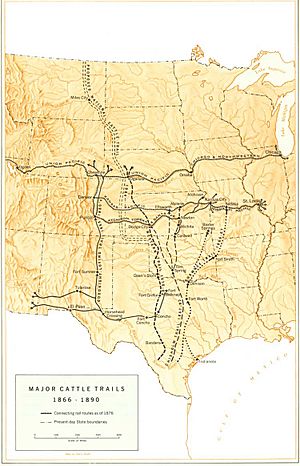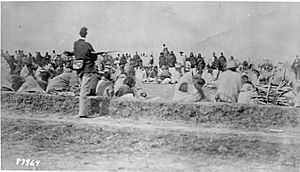Goodnight–Loving Trail facts for kids
The Goodnight–Loving Trail was a famous path used in the late 1860s. It helped move large herds of Texas Longhorn cattle across the American West. This important trail is named after two cattlemen, Charles Goodnight and Oliver Loving, who created it.
Contents
Where Did the Trail Go?
The Goodnight–Loving Trail started in Fort Belknap (Texas), in Central Texas. It then crossed a wide, flat area called the Llano Estacado (which means "Staked Plains"). The trail continued north along the Pecos River into New Mexico, reaching Fort Sumner. From there, it stretched further north into Colorado to the city of Denver. Later, the trail was even extended into Wyoming.
The First Cattle Drive in 1866
In June 1866, Charles Goodnight and Oliver Loving decided to work together. They wanted to drive cattle to new markets in the West. They hoped to sell beef to settlers, soldiers at army forts, and Navajos living on reservations near Fort Sumner.
They gathered 2,000 cattle and hired 18 cowpunchers. They successfully brought the herd to Fort Sumner, New Mexico. At that time, many Navajo people were living at the Bosque Redondo reservation. They needed food because farming conditions were poor, and the government had not planned well for supplies.
Goodnight and Loving sold their cattle for a good price. Goodnight then returned to Texas with about $12,000 in gold. He used this money to buy even more cattle.
Loving Continues North
Oliver Loving took the rest of the cattle and calves further north. His goal was to reach the railroad in Denver. On his way, he met Richens Lacey Wootton, who ran a tollgate at Raton Pass. Loving paid Wootton 10 cents for each cow to pass. In Denver, Loving sold the cattle to a rancher named John Wesley Iliff.
What Happened Next?
During another cattle drive in 1867, a big storm hit the herd near Horsehead Crossing. A group of Comanches attacked the cattle, scattering them. Loving and a cowboy named "One Arm Bill" Wilson rode ahead to Fort Sumner to explain the delay.
Sadly, they were ambushed by Comanches. Both men managed to escape, but Loving was badly hurt. He later passed away from his injuries.
Goodnight's Continued Drives
Even after Loving's death, Charles Goodnight continued to use parts of the trail. In 1868, he drove herds over Raton Pass again, paying the toll. By February 1868, he started driving cattle to Cheyenne, Wyoming. Here, the cattle were butchered and sold locally. They were also shipped by railroad to big markets like Chicago.
In 1868, Goodnight also found a new path through the Trincheras Pass. He used this route to sell cattle to John W. Iliff in Cheyenne. Iliff had become a very successful cattle rancher. He sold beef to mining camps, railroad workers, and government agents.
Over the next ten years, many new cattle ranches started in Wyoming. These ranches were stocked with Texas Longhorn cattle brought up the trail. Several Texas cattle companies even moved or started new businesses in Wyoming and Montana. Cheyenne became a major center for the cattle business because of its railroad connection.
See also
- Bose Ikard
- Lonesome Dove series - a fictional story inspired by the trail's history



